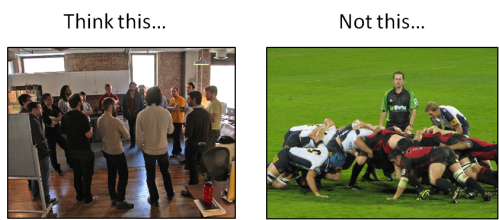When I say the word scrum, you probably immediately think of a two piles of rugby players huddled together on a field. Although we’ve covered sports topics before on the RMS Bunker Blog, this post will not be one of those. Scrum is a term picking up steam across the world in all types of companies that specialize in new product development. Although there are team huddles involved with this style of project management, cleats are not worn, uniforms (in most cases are not required), and the scrum usually takes place in a conference room rather than a muddy pitch.
Scrum is essentially a coined project management process for new product development. It attempts to take the often overwhelming process of developing new products within a company and tries to itemize and dissect the work into manageable tasks. It’s an agile form of product development that evolves as the product development progresses adjusting for barriers and roadblocks along the way.
Although there are many roles and responsibilities within the new product development team, two key stakeholders are the Product Owner and Scrum Master. The Product Owner is the “voice” of the product. He or she helps define the vision of the product, its benefit to end-users, and works on motivating team members, exciting customers, and inspiring management about the product. The Scrum Master is the “keeper” of the process. He or she is responsible for making the process run smoothly, for removing obstacles that impact productivity, and for organizing and facilitating the critical meetings. In practical terms, the Scrum Master is a modern-day Project Manager who uses efficiency metrics and predictive models to track timelines and manage staff. The Scrum Alliance offers certifications and training sessions for those interested in becoming Scrum Masters.
Scrum naturally breaks down into four key components:
- (1) Vision – this involves a large team formulating a strategic vision for the product involving the Product Owner, Scrum Master, potential end-users of the product (customers), team members, management, and executives.
- (2) Product Backlogs – simply put, these are the benefits the product will offer to customers, not the product features. An easy template to create these product backlogs is to create note cards that state: “As (persona), I want (what), so that (why).” An example using this template for the company Febreze would be: “As a soccer mom, I want an odor neutralizer, so that my mini-van won’t smell like soccer practice.” The idea here is to create as many product backlogs as possible written by all team members, and then filter the list down to the eight or ten that provide the most benefit to the end-user.
- (3) Sprint Backlogs – The Scrum Master works with team members decide how to break work into tasks, and how to allocate tasks to individuals through sprints. Sprints can last a long duration or last only a few hours. Even for the long sprints, the Scrum Master will take the 6 month sprint and break it into more management sprints. Sprints are broken down into three potential buckets, each with four duration:
- Months – 1 month, 2 months, 3 months, or 6 months
- Days – 2 days, 3 days, 5 days or 10 days
- Hours – 1 hour, 2 hours, 4 hours, or 8 hours
- (4) Product Increment and Release – after all sprints are completed or near completion, the Product Owner will make the final call as to whether implementations have the benefit descriptions and quality required for release.
Now, this wouldn’t be on our market research blog unless we were able to tie in market research to Scrum right? In reality, many synergies can be created between the Scrum process and market research. Market research can help fuel many components of new product development particularly in the vision and product backlog stages of Scrum.
Research & Marketing Strategies Inc. (RMS) can help your company facilitate a strategic planning retreat to discuss product visions. By using an independent third-party and moderator, it will ensure that feedback is objective and all levels of the organization participate to help drive product development. This strategic insight through RMS can be gathered through a variety of forms including stakeholder in-depth interviews (IDIs), employee surveys, and in-person focus group sessions to discuss vision.
RMS can also assist with product backlogs for Scrum. What better way to understand potential benefits of a new product concept than to directly ask the potential end-users themselves? RMS can use IDIs, telephone surveys, or online surveys to conduct product concept testing and inquire about potential product benefits directly from consumers. RMS will then analyze the data and prioritize the eight to ten product backlogs that will generate the most appeal.
RMS is a market research firm located outside of Syracuse, NY. If you are implementing Scrum at your organization and would like to further refine and add value to your new product development strategy, think about using market research. You can reach our President Mark Dengler at MarkD@RMSresults.com or by calling 1-866-567-5422.



